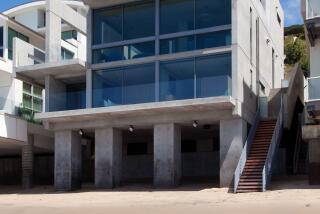BELL : James Bell House Renovation in a Fix
- Share via
Some say the James George Bell house is haunted. Others believe the 118-year-old structure, once a brothel, is occupied by the city’s mayor.
These are myths surrounding the Victorian farmhouse built by the city’s founder on a 350-acre ranch that is now the heart of Bell. But it’s no myth that attempts to restore the inside of the home are threatened by a lack of funds.
“Historic things are always put on hold when you have a tight fiscal concern,” said Annette Peretz, director of development services. “We have to take care of basics such as police services and infrastructure first.”
Unable to finance $250,000 to restore the landmark’s interior to its original state, the City Council voted last summer to put restoration plans on hold. Officials agree the house’s fate may remain in limbo as long as two years.
Councilman Rolf Janssen said the council’s decision was based on the fact that property-tax revenue is declining and fewer funds are trickling down to Bell from Sacramento. Community Development Block Grant funds cannot be tapped because the city has not registered the house with the state Office of Historic Preservation as a historic building, Peretz said.
The city purchased the house for $18,000 in 1968. Efforts to refurbish it began in 1989 when it was moved from Lucille Avenue to the Civic Center. The landmark had been taken from its original location at California and Gage avenues to Lucille Avenue about 1900.
The manor now stands at Pine and Gage avenues replete with rebuilt chimneys, a reconstructed screened-in porch and a new ramp for disabled visitors. The sky-blue exterior, including the original front door and Victorian detailing that underwent a recent two-year $150,000 renovation, belie what has become of the interior.
The morning sun shines through exposed redwood lath boards that line interior walls and 12-foot-high ceilings. The hardwood floor is dusty and cracked, and original wallpaper is peeling from above a large bay window seat.
Peretz said that the city’s plan to recreate the interior’s turn-of-the-century ambience is ambitious. “We have to replace some of the ceiling using redwood that will have to be specifically milled. Everything in here is specific,” she said.
A committee at the J. Paul Getty Museum is replicating old wallpaper by deciphering old patterns that were pasted over years ago. Workers will replaster interior walls instead of using dry-wall materials, Peretz said.
Light switches and a security alarm system will be hidden by a central switchboard that will control the electricity and plumbing, said Lawrence Winans, a preservation consultant to the city.
Officials hope to use the downstairs portion of the house, including the living, dining and kitchen areas, as a museum. Furniture donated by members of the Bell family is in storage, awaiting the renovation’s completion. Four bedrooms, an attic and a bathroom on the upper floor may be office space for the city’s Chamber of Commerce or the redevelopment agency, Janssen said.
Janssen said the home’s latest location has restored its significance as a landmark: “This house has helped to create a sense of community. We want people to understand we are a distinct city that was created by a family with a lot of history in Southern California.”
More to Read
Sign up for Essential California
The most important California stories and recommendations in your inbox every morning.
You may occasionally receive promotional content from the Los Angeles Times.






